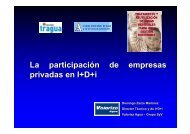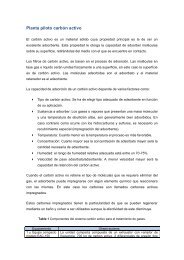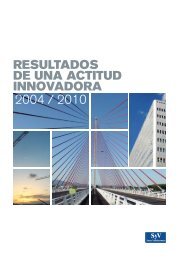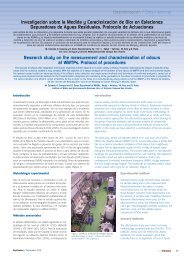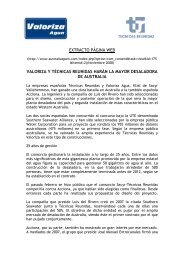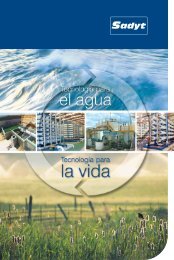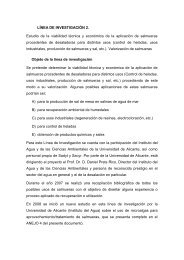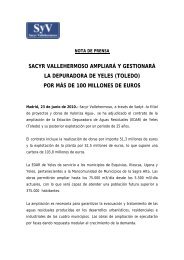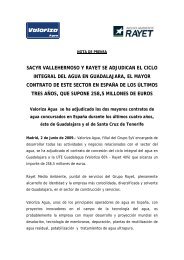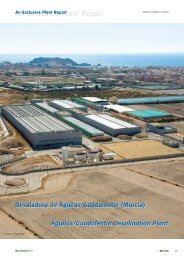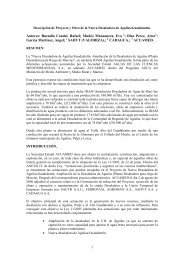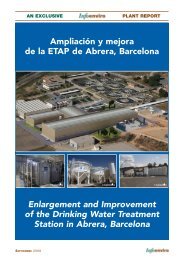D. Zarzo et al. / Desal<strong>in</strong>ation and Water Treatment 5Table 1Comparison of economic benefits <strong>in</strong> a farm us<strong>in</strong>g water from different sourcesWater orig<strong>in</strong>Superficial (Tajo-SeguraRivers transfer)Brackish waterfrom wellsPermeate fromBWRO plantWater price (e/m 3 ) 0.1322 0.054 a 0.2284 (<strong>in</strong>clud<strong>in</strong>g payback)Incomes (fruit sales) (e/year) 15,037 7,519 b 16,539 cExpenses (e/year) 3,885 3,885 4,273Benefit (e/year) 11,152 3,634 12,268Note: economic data were supplied by the farmer, participant <strong>in</strong> the study.a With well <strong>in</strong> property.b In this case the fruit production is below 50% compared to irrigation with superficial water.c Increased <strong>in</strong>comes due to the higher production.Downloaded by [Dom<strong>in</strong>go Zarzo] at 23:54 18 July 2012mations. Accord<strong>in</strong>g to the M<strong>in</strong>istry of Agriculture,Food and Environment these rates are <strong>in</strong>tended torecover the annual costs of operation, operation andma<strong>in</strong>tenance of the aqueduct, as well as to amortizethe <strong>in</strong>vestments made by the Government. The tariffshave been reduced more than 30% this year from0.174 to 0.124 e/m 3 . On the other hand, some environmentalorganizations, such as world wide fund <strong>for</strong>nature <strong>in</strong> Spa<strong>in</strong>, have compla<strong>in</strong>ed that the calculationof the new rates <strong>for</strong> the use of the Tajo-Segura aqueductseems to have not <strong>in</strong>cluded the environmentalcosts. Really these prices are fixed by the governmentand we do not know the real cost. We must bear <strong>in</strong>m<strong>in</strong>d also that accord<strong>in</strong>g with the EU Water FrameworkDirective is mandatory the full-price waterrecovery by 2010.Anyway, water transfer between different regionsis sometimes conflictive by political and economicalreasons and it is deeply affected by the weather conditions.It is generally admitted that water costs are areduced percentage of the overall cost of crop production,around 5%, although some authors reported thatthis could range between 5 and 25%, depend<strong>in</strong>g onwater price and even more than 45% <strong>for</strong> crops with ahigh water requirement (as oranges or lemons) [10].Other <strong>in</strong>terest<strong>in</strong>g data could be the differences <strong>for</strong> thesame product (e.g. tomatoes) when we compare production<strong>in</strong> greenhouses or <strong>in</strong> an open field, as shown<strong>in</strong> Table 2 [9].Table 2Effect of water price over the overall production cost oftomatoes (expressed as <strong>in</strong>crease <strong>in</strong> % of total cost)Water price (e/m 3 ) Greenhouses (%) Open field (%)0.12 2.2 50.54 9.3 19.3Source: Ref. [9].In an <strong>in</strong>terest<strong>in</strong>g report from the <strong>Spanish</strong> M<strong>in</strong>istryof Environment [11], the economic recovery of water<strong>for</strong> agricultural products was calculated. The resultsshowed that greenhouse products (horticultural, flowersand ornamental plants) provide greater addedvalue per unit of irrigated water with 5.79 e/m 3 onaverage <strong>in</strong> Spa<strong>in</strong>. Far from these values, with <strong>in</strong>termediateproductivity are v<strong>in</strong>eyards and fruit trees (1.08and 0.68 e/m 3 , respectively). On the other hand, thecereal gra<strong>in</strong> reach an average productivity of around0.06 e/m 3 , which be<strong>in</strong>g the ma<strong>in</strong> crop <strong>in</strong> Spa<strong>in</strong>, producesan average of 0.41 e/m 3 <strong>for</strong> all the products.In a study made <strong>in</strong> 2008 [12] by the community ofusers of water <strong>in</strong> the area of Nijar, Almeria, some<strong>in</strong>terest<strong>in</strong>g data here supplied about the productivityof water <strong>in</strong> <strong>agriculture</strong> (Table 3):In this case, water consumption per hectare was5,600 m 3 , with a total consumption of 150 hm 3 andwater productivity of 11.41 e/m 3 . The water costssupplied [12] were 0.22 e/m 3 <strong>for</strong> brackish water,0.44 e/m 3 <strong>for</strong> desal<strong>in</strong>ated water and 0.33 e/m 3 <strong>for</strong>result<strong>in</strong>g blended water.Another problem to evaluate the cost of water,ma<strong>in</strong>ly from desal<strong>in</strong>ation, is the energy price. Inrecent years, it has been <strong>in</strong>creas<strong>in</strong>g very fast, and dueto this, the ma<strong>in</strong> cost <strong>in</strong> a desal<strong>in</strong>ation production, thewater costs are cont<strong>in</strong>uously <strong>in</strong>creas<strong>in</strong>g (although thisTable 3Almeria and its production under plastic. Relationshipwater-harvestCrop Type Hectares Production value (<strong>in</strong>thousands of Euros)Greenhouses 26,833 1,714,969Lettuces 4,260 90,248Extensive (not lettuces) 3,277 97,852Total 34,370 1,903,069Source: Ref. [12].
6 D. Zarzo et al. / Desal<strong>in</strong>ation and Water TreatmentDownloaded by [Dom<strong>in</strong>go Zarzo] at 23:54 18 July 2012occurs also with water from other sources whenpump<strong>in</strong>g or other energy consumers are implied).However, there are public and private <strong>in</strong>itiativesus<strong>in</strong>g desal<strong>in</strong>ation <strong>for</strong> <strong>agriculture</strong> and it is predictablethat this will cont<strong>in</strong>ue to happen <strong>in</strong> the future.4. History of desal<strong>in</strong>ation <strong>for</strong> <strong>agriculture</strong> <strong>in</strong> spa<strong>in</strong>As it is well known, Spa<strong>in</strong> has historically sufferedimportant lack of water resources that has worsenedover time, <strong>in</strong>clud<strong>in</strong>g cyclic drought periods, like thecurrent situation. These problems are more important<strong>in</strong> the most drought prone areas <strong>in</strong> Spa<strong>in</strong>, such as theSouth Mediterranean coastal areas or <strong>in</strong> the islands(Balearic and Canary Islands).The history of desal<strong>in</strong>ation <strong>in</strong> Spa<strong>in</strong> starts <strong>in</strong> the60s, and we could summarize it as follows;1964: 1st desal<strong>in</strong>ation plant <strong>in</strong> Lanzarote (CanaryIslands).70s: construction of further desal<strong>in</strong>ation plants <strong>in</strong> CanaryIslands.80s: <strong>in</strong>stallation of desal<strong>in</strong>ation plants <strong>for</strong> irrigation <strong>in</strong>Canary Islands as well as on the ma<strong>in</strong>land.90s: <strong>in</strong>stallation of desal<strong>in</strong>ation plants <strong>for</strong> irrigation onthe ma<strong>in</strong>land, due to the severe drought.1995–2000: significant growth <strong>in</strong> <strong>in</strong>stalled capacity.2000–2005: execution of large desal<strong>in</strong>ation projects.Installation of desal<strong>in</strong>ation plants treat<strong>in</strong>g wastewater.2005–2011: AGUA Programme.2012: Current situation.4.1. The beg<strong>in</strong>n<strong>in</strong>g: Canary IslandsThe Canary Islands were the place <strong>for</strong> the beg<strong>in</strong>n<strong>in</strong>gof desal<strong>in</strong>ation <strong>in</strong> Spa<strong>in</strong> and Europe. The firstplant was <strong>in</strong>stalled <strong>in</strong> Lanzarote Island <strong>in</strong> 1964 <strong>for</strong>dr<strong>in</strong>k<strong>in</strong>g water supply. The plant had 2,300 m 3 /daycapacity and the technology was MSF. This plant wasfollowed <strong>in</strong> 1969 by Las Palmas I, <strong>in</strong> Gran Canaria,with 20,000 m 3 /day capacity by MSF.In the mid-seventies, the first plant <strong>in</strong>stalled <strong>for</strong><strong>agriculture</strong> was a small plant (80 m 3 /day) <strong>in</strong> Fuerteventuraus<strong>in</strong>g brackish water. The first seawaterreverse osmosis (SWRO) plant <strong>for</strong> irrigation was built<strong>in</strong> 1987 <strong>for</strong> the company Bonny <strong>in</strong> a plant called LasSal<strong>in</strong>as, with 6,900 m 3 /day capacity expanded to500 m 3 /day further. In 1988 <strong>in</strong> los Llanos de JuanGrande (Gran Canaria) another 6,000 m 3 /day capacityplant was built <strong>for</strong> <strong>agriculture</strong> with membranes (RO).This was followed <strong>in</strong> 1989 by another plant from acooperative society called Agragua, located <strong>in</strong> Galdar,Gran Canaria, with 15,000 m 3 /day us<strong>in</strong>g hollow fibremembranes.The first large desal<strong>in</strong>ation plant by membranes(RO) was built <strong>in</strong> 1990 <strong>in</strong> Las Palmas de Gran Canaria,with a capacity of 36,000 m 3 /day which has beenexpanded successively to the current capacity of80,000 m 3 /day.There are many examples <strong>in</strong> the Canary Islandsus<strong>in</strong>g Electrodialysis Reversal (EDR) as desal<strong>in</strong>ationtechnology <strong>in</strong> 90s. Some examples are between 1,000and 2,000 m 3 /day <strong>in</strong>clud<strong>in</strong>g plants with partial use <strong>for</strong><strong>agriculture</strong>, such as ICOD 2 (2,100 m 3 /day, 2003) orTamalmo (2,100 m 3 /day, 2003) [3]. The great expansionof the use of EDR <strong>in</strong> Canary Island is due to twoma<strong>in</strong> factors: the presence of silica <strong>in</strong> undergroundwater due to the volcanic orig<strong>in</strong> of the islands and agood commercial work from the EDR suppliers.Forecasts of the Canarian Government set a productionof desal<strong>in</strong>ated water of 188.0 hm 3 <strong>for</strong> 2012[13]. The most relevant current data on desal<strong>in</strong>ationare <strong>in</strong> Table 4.It is remarkable that the high number of private <strong>in</strong>itiatives(vs. the public ones) shows the relevant use ofdesal<strong>in</strong>ation <strong>for</strong> <strong>agriculture</strong> and tourism <strong>in</strong> the region.It is <strong>in</strong>terest<strong>in</strong>g to note that <strong>in</strong> Lanzarote and Fuerteventura100% of the dr<strong>in</strong>k<strong>in</strong>g water supply is from desal<strong>in</strong>ationplants and <strong>for</strong> Gran Canaria is around 80%.Accord<strong>in</strong>g to the same report, the current cost ofwater production from seawater is 0.5–0.6 e/m 3 ,whereas if the orig<strong>in</strong> is brackish water, the price is 0.2–0.3 e/m 3 . These values are consistent with those found<strong>in</strong> the rest of Spa<strong>in</strong> and <strong>in</strong> our own <strong>experience</strong>s.Balearic Islands also have an important desal<strong>in</strong>ationcapacity, around 30 hm 3 /year, but <strong>in</strong> this case,the desal<strong>in</strong>ation plants are ma<strong>in</strong>ly public ones <strong>for</strong>dr<strong>in</strong>k<strong>in</strong>g water supply be<strong>in</strong>g the orig<strong>in</strong> of water used<strong>for</strong> <strong>agriculture</strong> ma<strong>in</strong>ly from groundwater extraction orreused water. The authors have no <strong>in</strong><strong>for</strong>mation aboutany important plant <strong>in</strong> Balearic Islands <strong>for</strong> <strong>agriculture</strong>,although there are some plants <strong>for</strong> irrigation of golfcourses.The irrigation of golf courses, although it is notexactly an <strong>agriculture</strong> application, shares many char-Table 4Relevant data on desal<strong>in</strong>ation <strong>in</strong> Canary IslandsIslandDesal<strong>in</strong>ationplantsPublic Production (m 3 /day)Tenerife 44 5 118,143Gran Canaria 137 11 336,195Fuerteventura 64 4 65,049Lanzarote 80 0 62,570La Gomera 1 0 4,100El Hierro 4 4 2,000Source: Ref. [11].



